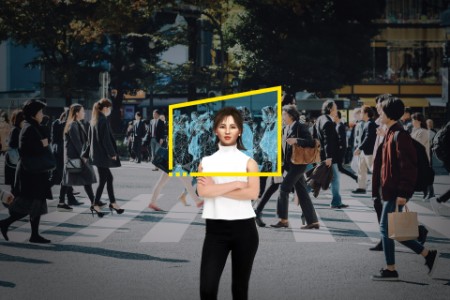Talking to the future consumer
It’s clear Sam and Wanyi are different people with different perspectives based on the future world scenarios they live in. Getting a view on their lived experience can help companies shape their business toward future scenarios and consumer behaviors.
Here are their responses to some of the conversations we’ve had with them:

Sam talks about the technology she can't live without
“I could not live without my AI assistant as it helps me stay organized and efficiently manage my life in my flexible subscription services that make sure my needs are taken care of wherever I go.
I enjoy taking a break from technology when I travel, but it’s hard to just unplug completely. A lot of the things I do depend on technology and even when I want to take a break, I’m usually reminded why it’s so useful!”

Wanyi talks about her love of shopping and keeping up with trends
“I follow trends and do a lot of research to stay informed, so I know where to find the best deals as well as items that fit my style. I also like to explore different brands and occasionally get custom-made fashion pieces.
Grocery shopping has become much more efficient with the help of personalization. I customize orders based on dietary preferences and have my groceries delivered to my door. I discover new products through social media, AI recommendations and browsing online and in physical stores.”
What will it take to win in their worlds?
Sam and Wanyi live in different future scenarios and provide different perspectives on their world. But in both cases, there are strong similarities in the issues they face and the technologies they use. Both rely heavily on AI to help curate large parts of their lives, hinting that most perspectives on the future will arrive at a scenario where AI and automation are heavily integrated to shape consumer lifestyles and drive better business practices. But there are differences too and exploring what it takes to win in their worlds will help identify the products, services and business models required to thrive in the future.
Winning in Sam’s world
Sam lives in a world where people consciously limit what they own and instead subscribe to services that help them live an on-demand lifestyle. Asset-light consumers are no longer possessed by their possessions and take advantage of their freedom to live and work how and where they choose. Their lived experience is international, and they engage virtually to keep in touch with a global social network. Geographic communities have less relevance, but new places and cultures provide fantastic new experiences. People expect to feel “at home” wherever they happen to be and are always keen to learn new skills and try new experiences. Travel time between locations becomes highly productive. They have multiple professions and relationships, which their AI helps them to manage. Companies will need to engage not only with them but also with their AI to break into their circle of trust. Those brands that they do trust must use a demand-led supply chain and distribution ecosystem to “follow” their consumers wherever they go and provide relevant, contextual products and services that match their immediate needs.
Winning in Wanyi’s world
Wanyi lives in a world where people are so keen to experience enjoyable, novel and convenient experiences that the retail landscape has transformed to blend shopping with leisure. Immersive shopping is one of the most exciting and rewarding experiences in everyday life, while mundane buying transactions are taken care of by AI — swiftly, silently and conveniently. Consumers are quick to embrace retail innovations that remove friction or give them compelling brand experiences. Shopping is a social activity and shops are multifunctional spaces that help consumers enjoy more than just buying products. Consumers have confidence in AI to manage large parts of their lives, especially in guiding their wellness through tailored dietary recommendations and exercise. Concepts of convenience and experience are redefined to push companies to innovate relentlessly. “Good enough” products are not good enough and consumers use co-creation to help brands innovate and take a share of the value created. Social scoring influences the choices consumers make and the brands that they engage with and high brand scores provide a license for companies to operate.
Brands that prosper can anticipate constantly evolving consumer demands and find new ways to delight and entertain. Emerging technologies embed the brand experience into every aspect of the consumer’s life. From VR to local events, the experience is consistent, connected and compelling across every imaginable touchpoint. Everything is social, with consumers receiving a seamless flow of choices, recommendations, and feedback from across their networks that AI curates by taking care of mundane purchasing, so consumers can use the scarce time they have to live the lives they want.
To win in Wanyi’s world, companies must consider how they:
- Align digital and physical assets to ensure a seamless and consistent transition between channels. Stores will become temples to the brands they sell.
- Shift operating models to provide baseline designs that consumers can play with and create themselves (not simply deliver physical brands and the end product through retail).
- Create competitive advantage by focusing on enhanced services, advice and curation that make brand experiences both fun and informative.
- Align purpose with regulators to satisfy brand citizenship needs, delivering high service levels at the same time to prevent damaging scores from consumers.
- Let consumers define the brand, not brands define the consumer.
Which future consumer are you designing for?
As companies build their capabilities for tomorrow, the need to understand what that future might look like has never been more acute. Seeking to understand the implications of today’s trends in the longer term will help to shape strategies. Looking at how the consumer of today is evolving will help to establish a sense of where the consumer is going. But it is only by imagining what tomorrow might look like, who might inhabit it, and what their habits, behaviors and needs will be that companies can bring the future to life, as a tangible place for companies to thrive in.
By using future scenarios to explore possible implications of long-term trends, companies can design for different futures by identifying how their value propositions will need to evolve, what their operating landscape might look like and, most crucially, the capabilities they will need to future-proof their business against multiple scenarios. This process can allow companies to:
- Identify what they need to become
- Test and challenge their current offerings
- Explore what they need to build to succeed
- Create a roadmap for change
Explore future world scenarios
Summary
Tracking today’s trends and behaviors will not be sufficient as companies seek to future proof their business. The EY Future Consumer program has developed distinct future world scenarios. Using technologies, including GenAI, we can bring to life these imagined futures by talking to the consumers living in these future worlds. Using the power of immersive storytelling, we can help companies picture what future consumers will need. Companies may not be able to predict the future, but they can use today’s technology to explore what it might mean for them and how they should transform to meet it.


